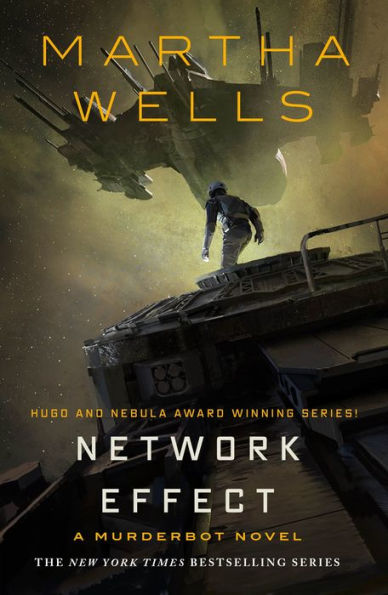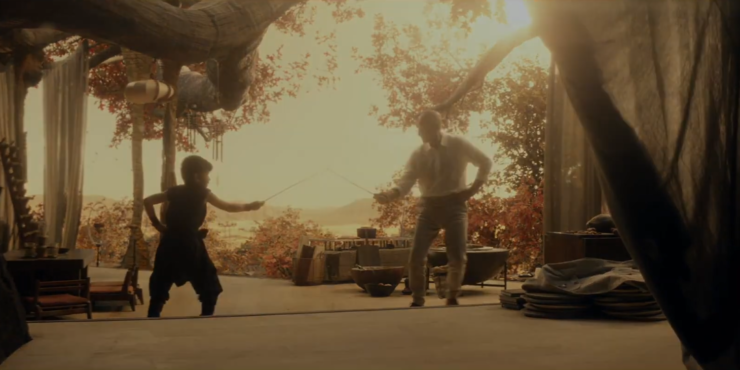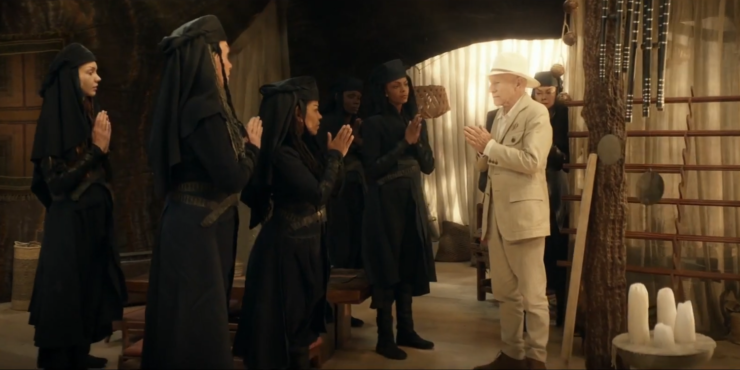And so Jean-Luc Picard has finally gotten off Earth, so now the action can start, right?
Well, sorta kinda. Picard makes a stop on the way to Freecloud (to Musiker’s annoyance), and we get yet still more backstory and exposition, as well as at least a little bit of action, as well as a couple of amusing original-series callbacks.
Having said that, we’ve gotten more cultural details about the Romulan people in these four episodes of Picard than in the entirety of the previous 53 years’ worth of TV shows and movies, so there’s that…
The Romulans were introduced in “Balance of Terror” in 1966, during the first season of the original series. Later that season, in “Errand of Mercy,” the Klingons were introduced. The two empires have continued as both antagonists and allies in the years since, but the Klingons have received considerably more focus. They appeared in six episodes of the original series, where the Romulans were only in four (and in two of those, “The Deadly Years” and “The Way to Eden,” no Romulans actually appeared). Due to Worf being part of the Next Generation and Deep Space Nine cast, and B’Elanna Torres being part of the Voyager cast, those three shows tended to explore Klingon culture more than Romulan culture, and with notable exceptions like TNG’s “Unification” two-parter and especially the brilliant “Face of the Enemy,” comparatively little was done with the Romulans. Many episodes (“Tin Man,” “In the Pale Moonlight,” “Message in a Bottle,” “Babel One”/”United”/”The Aenar”) and movies (Nemesis, the 2009 Star Trek) that have had them as the bad guys still didn’t really do anything with them.
Buy the Book


Network Effect
Picard has changed that. Every episode has had new revelations about the Romulan people, and it’s been glorious, from the card games they play to the concept of Ganmadan (basically the Romulan version of Ragnarok) to the introduction of the Bene Gesserit—er, that is, the Qowat Milat, a group of, basically, warrior nuns. They follow the practice of absolute candor (hence the episode’s title), which I love. The Romulans were established from jump as an offshoot of the Vulcan people, and this is an interesting notion that feels like it evolved from Vulcan’s embrace of logic and the oft-stated dictum that Vulcans do not lie. The Qowat Milat always tell the truth, regardless of how unpleasant that might make things.
A bit of history: While it’s never been made explicit onscreen, it’s generally been assumed that the Romulans broke away from Vulcan around the time of Surak’s adoption of the principles of logic and suppressing one’s emotions, philosophies that the Romulans themselves do not follow in the least. This in particular has been explored in various works of tie-in fiction about the Romulans. The assumption has often been that they left because they rejected Surak’s logic, but the Vulcan’s Soul trilogy written by Susan Shwartz and the late Josepha Sherman has a different, very nifty take: that the Romulans were Vulcans who were sent off world by Surak with his blessing, because the chaos on Vulcan in Surak’s time was such that he was concerned his teachings about embracing logic wouldn’t survive. The intent of the exodus to Romulus was to preserve Surak’s teachings, but the hardships of the journey across the stars led to the Romulans instead rejecting Surak.
The Qowat Milat feels very much like a remnant of the Romulans’ Vulcan past (especially given the matriarchal hints seen in places like “Amok Time,” and aided by the outfits that look very much like those worn by female Vulcans in that episode as well as The Motion Picture and The Search for Spock and various Enterprise episodes). It helps that Amirah Vann, the only Qowat Milat with a speaking part aside from Elnor (more on him in a minute), imbues Zani with a regal-yet-friendly presence that reminds me favorably of Camille Saviola’s portrayal of Kai Opaka on DS9.
We meet the Qowat Milat in Yet Another Expository Flashback, as we see the planet Vashti, the hub for the relocation of Romulan refugees following the supernova that was the impetus behind the story of the 2009 Star Trek. Picard has made friends with some of the refugees, particularly the Qowat Milat, who have aided in the relocation efforts, and especially a young boy named Elnor, whom the Qowat Milat have taken in.
Elnor is played as a boy by Ian Nunney, and then in the present as an adult by regular cast member Evan Evagora (listed in the opening credits for the first time here), and I gotta say I liked him better as a kid who eagerly devours the copy of Alexandre Dumas’s The Three Musketeers that Picard gives him and who learns how to fence than I do the dour grownup. I must confess to thinking of Elnor as I saw him in the previews and promo material as Space Legolas (his Tolkien-ish name aided in that), and then at the top of the episode I was thinking he’s more Space d’Artagnan—but by the time the episode ended, I realized he’s Space Yojimbo, as he feels a lot like he’s channeling Toshiro Mifune’s ronin character in Yojimbo, Sanjuro, and Machibuse.

Men generally don’t get to be Qowat Milat, but Elnor—an orphan with nowhere else to go whom Zani and the others took in—has trained to become one of them anyhow. Picard comes to Vashti for the extra muscle that a Qowat Milat would provide, and he knows he can count on their help because, as is revealed at the very end, they will only pledge their sword to a notion if it’s a lost cause.
Elnor, is pissed that Picard basically abandoned him—a feeling shared by most of the Romulan population of Vashti, expressed verbally by a former senator. Tenquem Adrev, played with eloquence by Evan Parke, rips the Federation in general and Picard in particular for how they handled the refugee crisis. Adrev then challenges Picard to a duel, and it’s always fun to see Sir Patrick Stewart wield a sword. He actually does so twice in the episode. However, Elnor then beheads Adrev in one swipe, which is also when he announces that he’s decided to dedicate his sword to Picard’s cause despite being annoyed with him.
(That sword, by the way, must be made of some kind of impressive alloy and sharpness, as—despite what you may have been told by the Highlander franchise—it’s damn near impossible to behead someone with one swipe of a sword. There’s a whole lot of bone and muscle in the neck to hack through, and there’s a reason why beheadings are usually done via things like guillotines, which build up a lot more momentum than a sword swipe ever could.)
Back on La Sirena they have their own problems, as they come under attack by a local gang leader, and here’s where we get the two original series callbacks. The first is simply that the actors all have to shake in their seats and bounce around the bridge—though nobody actually falls out of their chairs, which would make the callback complete. And the reason why they’re bouncing around is the second callback, as the gang leader who’s attacking them has an old-style Bird of Prey, the Romulan ship we saw used in “Balance of Terror” and “The Deadly Years.” It’s fun to see that model—which TNG abandoned in favor of the warbird design—given the 21st-century F/X treatment. While I normally don’t give a hoot about ship design, this particular one was a delight.
The attack is mostly there so that the rest of the cast has something to do, and even at that, they’re not entirely successful. Musiker really needs more to do than bitch to Picard and then go ahead and do what he asks anyhow, though Michelle Hurd continues to play her with an acid bitterness that obscures brilliant competence and professionalism. And Jurati has literally no purpose in this particular story, but she’s on the ship, so they turn her into Sylvia Tilly for an episode, babbling annoyingly at Rios while he’s trying to read and generally just providing word vomit to fill time and justify Allison Pill’s place in the opening credits.
Santiago Cabrera is having way too much fun playing the various holograms on the ship. Having met the medical and navigation ones, this time ’round we get the Emergency Hospitality Hologram (who re-creates Picard’s study in Labarre on La Sirena‘s holodeck so they can keep using the set) and “Emmett,” who is apparently a pilot, and who mostly only speaks Spanish. He also looks like he’s just been on a bender.
I must confess to being real curious about how these various holograms came about and who programmed them and any number of other things. Rios declares angrily, “I hate that fucking hospitality program,” and in fact the EHH deactivates the minute Rios walks into the room, which is obviously a standing order. It feels like he didn’t choose the holograms, but they all look like him. It’s actually kind of entertaining, and it’s a great acting exercise for Cabrera—which is good, as the character of Rios is still pretty nowhere.
We’ve already seen the Federation’s side of the decision to abandon the Romulan refugees to their fate, and this episode shows us the Romulan side of it, and I continue to intensely dislike this particular plot choice. Again, we’ve been down this road before with the Klingons in The Undiscovered Country, not to mention the fact that the Federation has always been about helping people, going all the way back to “The Corbomite Maneuver” when the Enterprise offered to aid the First Federation ship when they appeared to be in distress even though that ship had been nothing but hostile. The entire history of the franchise is one where our heroes help people even if they’re an enemy, whether it’s the Gorn captain that Kirk’s been put into an arena with or the depowered entity who’s now stuck on your ship and being menaced by the Calamarain or the Jem’Hadar who were attacked by rogue elements or the various hostile Delta Quadrant powers that Voyager encountered but nonetheless provided help to when needed, and on and on and on, including the entire arc of Enterprise that showed Earth bringing species that were at loggerheads together to form the Federation. The Dominion War ended, not due to military might, but due to an act of compassion: Odo offering to return to the Great Link and cure the Founders of the disease that was ravaging them. It’s not a coincidence that dozens of Star Trek episodes open with the crew responding to a distress call.
So the entire foundation of Picard is one I’m having incredible difficulty wrapping my brain around. This is not what Starfleet has ever been, and I’m just not buying it right now.
The title character isn’t exactly coming off well, either. Last week we found out that he abandoned his aide when he resigned, and this week we learn that he abandoned an entire planet full of refugees. Picard just flushing and restarting his life is one that has had awful consequences, ones that he doesn’t really seem to be facing. There’s handwavey gestures toward it, but ultimately, Picard is getting off pretty easy for being a total douchecanoe, and I really hope that the series remembers that actions have consequences that can’t be solved by saying “I’m sorry” in Stewart’s lovely, heartfelt voice.
I haven’t even mentioned the Borg Cube part of the story yet, but that’s mainly because not a whole helluva lot actually happens there. Narek continues to seduce Soji (there’s an adorable scene of them sliding down a very smooth surface) and Rizzo and Narek continue to channel the Lannister siblings for no compellingly good reason. We do get one revelation, though: apparently the Tal Shiar/Zhat Vash think there are lot more than two daughters of Data, as Rizzo indicates that there’s a whole mess of synths that look like Isa Briones out there somewhere, and Narek’s attempting to learn where they are without activating her and turning her into the killing machine that Dahj turned into.
The episode ends with Jeri Ryan pulling a Leonard Nimoy by being listed as a special guest star in the opening credits, but not actually appearing until the very last second with one line of dialogue. Nice work if you can get it. We’ll get more of Seven of Nine next week when we finally get to Freecloud, and hopefully the whole cast will have something to do…
Keith R.A. DeCandido picked that title for the review because St. Jude is best known as the patron saint of lost causes in Christian lore.










